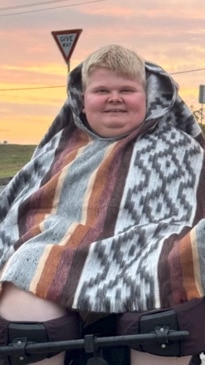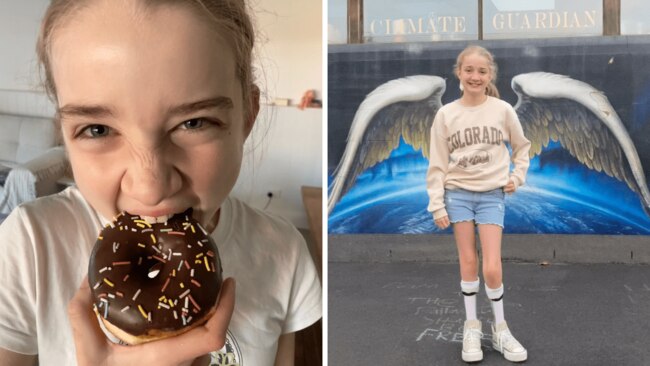Doctors said my 13yo had hip dysplasia, now she can’t open doors by herself
“That’s the cruel thing for me as her dad … this is taking too much away from her.”

Family Life
Don't miss out on the headlines from Family Life. Followed categories will be added to My News.
On the surface, Harper looks like any other happy 13-year-old.
But when she was a baby, her mother knew something wasn’t quite right; Harper started developing "a different gait” to other kids her age, slapping her feet rather than walking from heel to toe."
Harper’s parents drove her from their home in Albury to the Royal Children’s Hospital in Melbourne, where doctors first thought she may have misdiagnosed hip dysplasia.
The reality was far worse.
Want to join the family? Sign up to our Kidspot newsletter for more stories like this.

“She can't move her toes, her feet or her ankles at all”
After a bit of back and forth, doctors realised she didn’t have hip dysplasia as they once expected.
She had Charcot Marie Tooth Disease (CMT), a degenerative nerve disease that attacks the feet and hands.
RELATED: 'My 4yo has had a wheelchair for two days, and she's already experiencing discrimination'
The weakness begins at the “furthest-most points” of her body, meaning her “toes, feet, ankles and in the upper limbs, so the arms, her fingers and hands are weakening quite rapidly”.
“She can't move her toes, her feet or her ankles at all,” dad David told Kidspot.
Life for Harper isn’t always easy. Now 13 years old, she has been living with CMT for close to 10 years.
But as she grows, so do the problems with her movement.
Introducing our new podcast: Mum Club! Listen and subscribe wherever you get your podcasts so you never miss an episode.
Strapped with ankle-foot orthotics (AFO), a hard plastic bracket that supports her ankles and strengthens her “weak structure”, she is able to live her life as a normal teen as much as possible.
“She can walk around on them, and even though she can't move her toes, feet and ankles with AFOs on, she can walk reasonably well,” David said. “She fatigues quite quickly, bu with a handrail, she can get upstairs.”
While she tries her best to keep up with other kids her age, it doesn’t take long for her to feel exhausted. Generally, if Harper wants to do something, it will take her three times more energy than everyone else, making getting through a full day of school extra challenging.
While the severity of her CMT isn’t driven by the seasons, it appears that the cold weather makes life “a little bit more difficult” for the teenager. Because of this, during winter, Harper is forced to take a day off from school every week.
“Her body retains the cold more than mine does or what's expected,” David told Kidspot. He described her nerves like a telephone wire, but the connection is “always deteriorating”, so while the “message can get through”, it’s “not as good as it can be”.
RELATED: My electricity bill has doubled since charging my daughter's electric wheelchair

Struggles with everyday tasks
For the last seven years, the CMT has affected mostly her legs and feet, but three years ago, her hands started to become weaker. She started high school this year, but the NSW girl is now unable to hold a pen or pencil, “so now, writing is becoming more and more difficult for her”.
Even small tasks like “opening a laptop” and “using a touch screen” have become exceedingly tough; Harper can’t “undo buttons” or “turn keys in locks”.
“She really struggles to open the car door,” her father told Kidspot.
Through it all, while Harper is a “shy girl”, she tries not to let the illness get the best of her. “She does have some added anxiety, but she's really willing to give everything a shot,” he continued.
As she heads towards the ten-year anniversary of her diagnosis, the now-13-year-old is still undergoing therapy in Melbourne, including swimming which her father described as “physiotherapy dressed up as fun”.
While Harper undergoes therapy for her CMT, sadly, there is no cure.
RELATED: He's getting worse without a special stroller thanks to the nightmare of NDIS

“We don't want it to get worse before it gets better”
Unable to use a manual wheelchair due to her weakened hands, Harper was recently given a motorised wheelchair to help her get around.
And it’s changed her life.
“Now she can zip around in a manner that she has never been able to before,” David said. Whenever she can, the teenager loves to head to the skatepark in her wheelchair.
“The very first day that she got her motorised wheelchair, she wanted to go straight to the skate park,” David told Kidspot. “So, she was up and down some of the ramps in the skate park because she wanted to have fun.”
“The cruel thing for me as her dad is that CMT is taking too much away from her.”
While the wheelchair is a blessing for Harper, it still has its challenges.
Unable to fit the wheelchair into the family car, David finds it exceedingly troublesome to try and get his daughter down to Melbourne for her therapy sessions.
“It can't be collapsed; not even an Olympic weightlifter could lift it,” he said. Because it requires a centre of balance for the person sitting inside, the wheelchair is far too heavy to load into a car, or even a regular van, without “significant modifications”.
“If we need to go to the Royal Children's Hospital, we can't take that wheelchair,” he said. The same goes for family holidays; with their relatives living in Sydney, they’re unable to take the motorised wheelchair with them, leaving Harper feeling less independent than ever.
Getting to school every day is as much of an issue. “We have no way of independently transporting Harper to school with her wheelchair,” he said.
David has set up a GoFundMe campaign to raise money for a wheelchair-friendly van, which he can use to transport her everywhere and help Harper maintain her independence.
“I'm seeing a young girl become more and more aware of her illness and her disability,” he said. “We don't want it to get worse before it gets better.”
You can find out more about Harper’s GoFundMe here.
More Coverage
Originally published as Doctors said my 13yo had hip dysplasia, now she can’t open doors by herself





